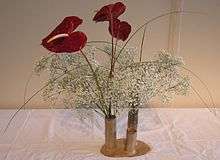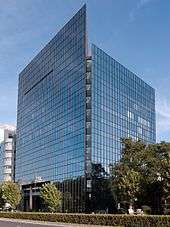Sōgetsu-ryū

Sōgetsu-ryū (草月流) is a school of Ikebana, or Japanese floral art.
History
Sogetsu was founded by Sōfu Teshigahara in 1927.[1] Sofu's father was an Ikebana master, who taught his son from childhood. Sofu wanted to become a painter, but he found that the possibilities for creative expression in using green materials are endless, just as in painting.[2]
He found that the strict rules of traditional ikebana did not allow individual expression. He broke away from traditional ikebana and formed his school in 1926.[3] In the beginning, he promoted the school through radio.
As of 2016, there have been four headmasters. Sofu's daughter Kazumi was a gifted artist. She became the second headmaster until she passed away at age 47. Her elder brother, film director Hiroshi Teshigahara, took over. The current headmaster is Akane, Sofu's granddaughter.[3]
The Sogetsu school is an open-minded and avant-gardist school. The school was one of the first to have English textbooks.[4]
A famous saying by Sofu Teshigahara and credo of the Sogetsu school is that Sogetsu can be done by anyone, anywhere, anytime with any kind of material. [5]
The school is led by Akane Teshigahara, the founder's granddaughter.[6] Noted practitioners include Master Instructor Koka Fukushima, whose masterclasses worldwide have received acclaim in floral art circles.[7]
The headquarters was constructed by the architect Kenzo Tange.[8]
Styles
Sōgetsu typically uses either a tall, narrow vase such as one made from a bamboo stem, or a flat, open dish in which the flowers and branches are fixed in a hidden kenzan spiked support. However, other forms are possible, including highly elaborate creations that fill an entire hall. The arrangements in a tall vase are called Nageire, the once in a shallow container are called Moribana.
One of Sōgetsu's central ideas is that an arrangement should have three strong elements, each with certain proportions and arranged at a certain angle. But there is considerable latitude to work with whatever materials are available and to express the spirit of the moment.
References

- ↑ "Ikebana International".
- ↑ Teshigahara, Sofu (1979). Kadensho, the book of flowers. Sogetsu Shuppan Inc. pp. 9–12. ISBN 4-88145-001-8.
- 1 2 "IKEBANA SOGETSU Time-line - Know Sogetsu".
- ↑ Beunen, Ilse (2015). Exploring Ikebana. Stichting Kunstboek. ISBN 978-90-5856-504-4.
- ↑ Teshigahara, Hiroshi (1986). Ikebana Sogetsu. Shufunotomo co., Ltd. p. 1. ISBN 4-07-974618-0.
- ↑ "IKEBANA SOGETSU Profile - Sogetsu and Akane Teshigahara".
- ↑ Kenrick, Vivienne (13 August 2005). "Koka Fukushima" – via Japan Times Online.
- ↑ "IKEBANA SOGETSU Sogetsu HQ Building - Know Sogetsu".
External links
![]() Media related to Sōgetsu-ryū at Wikimedia Commons
Media related to Sōgetsu-ryū at Wikimedia Commons